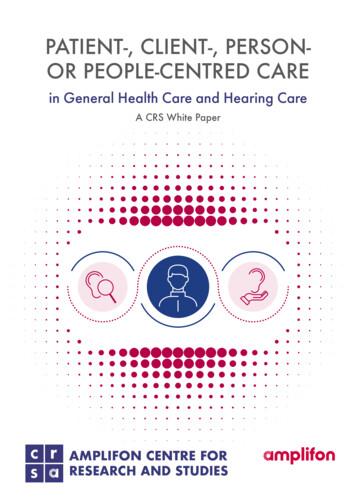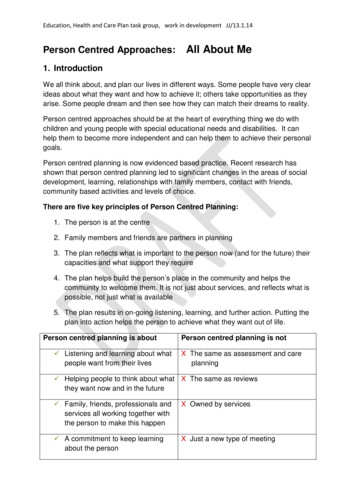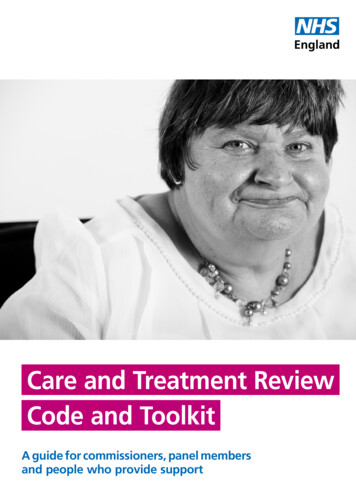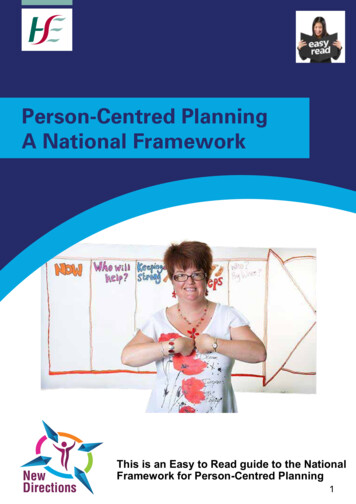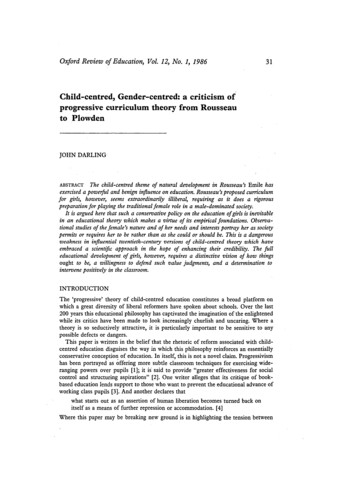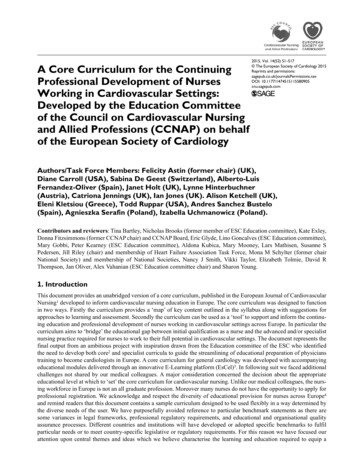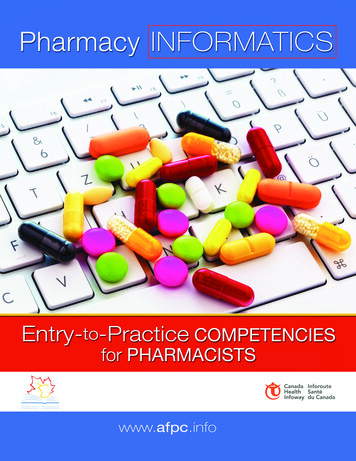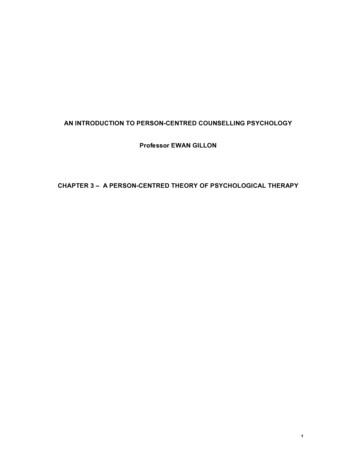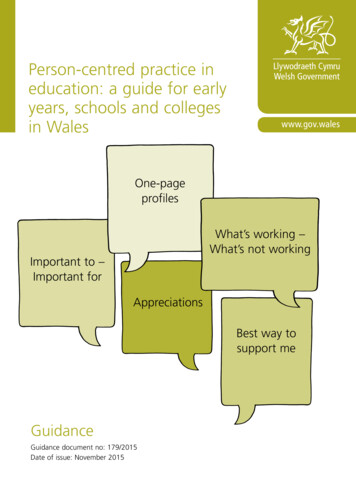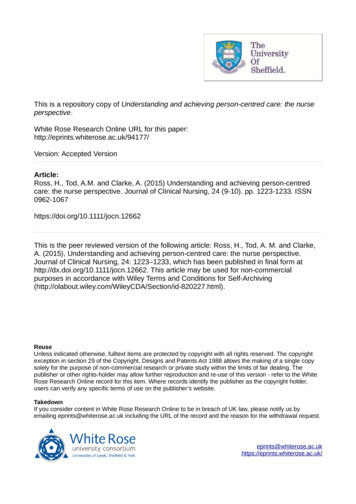
Transcription
This is a repository copy of Understanding and achieving person-centred care: the nurseperspective.White Rose Research Online URL for this : Accepted VersionArticle:Ross, H., Tod, A.M. and Clarke, A. (2015) Understanding and achieving person-centredcare: the nurse perspective. Journal of Clinical Nursing, 24 (9-10). pp. 1223-1233. s is the peer reviewed version of the following article: Ross, H., Tod, A. M. and Clarke,A. (2015), Understanding and achieving person-centred care: the nurse perspective.Journal of Clinical Nursing, 24: 1223–1233, which has been published in final form athttp://dx.doi.org/10.1111/jocn.12662. This article may be used for non-commercialpurposes in accordance with Wiley Terms and Conditions for ection/id-820227.html).ReuseUnless indicated otherwise, fulltext items are protected by copyright with all rights reserved. The copyrightexception in section 29 of the Copyright, Designs and Patents Act 1988 allows the making of a single copysolely for the purpose of non-commercial research or private study within the limits of fair dealing. Thepublisher or other rights-holder may allow further reproduction and re-use of this version - refer to the WhiteRose Research Online record for this item. Where records identify the publisher as the copyright holder,users can verify any specific terms of use on the publisher’s website.TakedownIf you consider content in White Rose Research Online to be in breach of UK law, please notify us byemailing eprints@whiterose.ac.uk including the URL of the record and the reason for the withdrawal terose.ac.uk/
UNDERSTANDING AND ACHIEVING PERSON -CENTRED CARE: THE NURSE PERSPECTIVE.ROSS H. TOD AM. CLARK A.ABSTRACTAim. This paper presents findings from the first stage of an exploratory study investigating nurses’understanding and facilitation of person-centred care within an acute medical ward.Background. The term ‘person-centred care’ is used frequently in healthcare policy and practice.However, the ways in which the concept is translated into everyday nursing care continues to presenta challenge. Person-centred care has been explored extensively within the care of older people,people with dementia and people with a learning disability. Little empirical research has beenconducted in acute ward settings. This paper starts to address that gap.Design. The study used an Action Research approach.Methods. Individual semi-structured interviews were conducted with a purposeful sample of 14nurses. Framework Analysis was used to analyse the dataResults. Nurses had a clear understanding of person-centred care in the context of their work. Theyacknowledged the importance of relationships, personal qualities of staff and respecting theprinciples of person-centred care as they strived to provide safe, high quality person-centred care.Relevance to clinical practice. In the light of recent criticisms of nursing and the implied erosion ofpublic confidence in the provision of high quality healthcare, it is important to recognise good practiceand use the findings as a foundation for further and sustained development in providing personcentred care.Conclusion. The examples of care given by the nurses in this study resonate with the ‘six Cs’emphasised by the Chief Nursing Officer for England in 2012, acknowledge the motivation of nursesto provide person-centred care and will contribute to the ongoing debate about nursing practice.What does the paper contribute to the wider global clinical community? Findings build on the existing knowledge of person-centred care. Principles are applicable to other clinical settings. Results are relevant to clinical practice and pre and post-registration nurse education.1
INTRODUCTIONOver recent years, there has been a negative and critical focus on health care and nursing,particularly in the media (Cavendish 2011, Adams & Smith 2012, Patterson 2012). In some cases,this has been in response to specific investigations into care quality; such as the independent inquiryinto care provided by Mid Staffordshire NHS Foundation Trust (Francis 2010, 2013) and the abuseof residents of Winterbourne View (Department of Health (DH) 2012). Such events concern both thepublic and health professionals and have stimulated an on-going appraisal of health care quality andcaring roles. (DH 2012, Abraham 2012, Cavendish 2013, Hemingway 2013, Lilley 2013).As a result of these failings the Chief Nursing Officer for England has called for a rediscoveryof compassion in nursing (Department of Health and NHS Commissioning Board 2012) in order toprovide high quality care. When reflecting upon the concerns presented in media debates it is easyto blame individuals, managers or government policies (Lilley 2012, 2013). However it is also worthtaking into account other aspects of the debate, such as the strength of evidence indicating nursingcare quality has diminished and not committed to person-centred care. This paper presents keyfindings of an on-going research study conducted in a large teaching hospital in the UK. The studyseeks to identify nurses’ understanding of person-centred care (PCC) and what factors facilitate suchan approach to care within an acute medical ward.Literature and backgroundThe term person-centred care (PCC) is used frequently in healthcare. However, its use and definitionvaries in different policy, guidance, research and in everyday practice (Goodrich & Cornwell 2008,Goodrich 2009). The ways in which the concept is translated into everyday nursing care continuesto present a challenge (McCormack 2004, Price 2006, Edvardsson et al. 2008, Goodrich 2009,McCormack & McCance 2010, Nilsson et al. 2013).Whilst much is written about PCC in general terms, there are few empirical studies that examine itsuse and impact on care quality and outcome in acute care. PCC has previously been explored inthe literature, particularly with reference to the care of older people, people who have dementia and2
people who have a learning disability (Kitwood 1997, Ford & McCormack 2000, Nolan et al. 2002,2004, Thompson 2004, Brooker 2007, Peek et al. 2007, Edvardsson et al. 2008, McKeown et al.2010, Kirkley et al. 2011).McCormack and colleagues have conducted a series of rigorous studies mostly based in thecare of older people (McCormack 2003, McCormack & McCance 2006, McCance et al. 2008,McCormack et al. 2009, McCormack et al. 2011). Their work emphasises the value of the nurse’srelationships with the person and their family, but also the need for seeing broader influences onperson-centred practice. They identify the importance of elements such as the dynamics of powerand control, the effect of institutional discourse, authenticity, the care environment, appropriate skillmix, effective staff relationships and shared values within the team (McCormack & McCance 2006,2010). These and other concepts drawn from this programme of work were used to develop aperson-centred framework for nursing, using it as the basis for a series of practice developmentprogrammes (McCormack & McCance 2010).Other researchers have developed instruments and indicators to measure factors thatinfluence PCC from patients’ and nurses’ perspectives (McCance et al. 2008, Edvardsson 2009,Slater et al. 2009). These factors include: relationships in the care setting, involvement in decisionsabout care and the culture of the care environment. Whilst the focus of these studies is on theindividual, many elements have congruence with the relationship centred approach seen as essentialto the ‘Senses’ framework by (Nolan et al. 2004, 2006). The framework was developed specificallyto address nursing practice and education in the care of older people. It emphasises the need foreach person (patients, family and staff alike) to feel valued and recognised as a person throughrelationships which are satisfying to all. The need for skilled, knowledgeable and enthusiastic staffworking in an open and encouraging environment where there is mutual respect and trust are alsocommon features of person-centred frameworks (Kitwood1997, Nolan et al. 2004; McCance et al.2011). These factors identified in the literature show how multifaceted PCC is and how realising it ineveryday nursing practice can be a challenge.3
Some of the challenges to PCC that have been identified include conflict betweenbureaucratic management systems, which focus on budgets and commissioning, and care givers’concerns about individual care needs (West et al. 2005; Innes et al. 2006; Kirkley et al. 2011, Nilssonet al. 2013). This mismatch between priorities of managers and of staff working at the grassrootscan cause tension. Instead of creating a positive culture in the care environment, it can result in stafffeeling less engaged with care needs (McCormack 2011).Further research is recommended to facilitate a clearer understanding of the meaning andapplication of PCC in everyday practice (McCormack 2004, Nilsson et al. 2013). Whilst much of theprevious research focuses on the care of older people, people with dementia and care homeenvironments, a few publications explore the application of PCC in acute hospital settings (Peek etal. 2007, Gribben & McCance cited in McCormack & McCance 2010, NHS Education for Scotland2012). However there remains limited focus on the staff perspective of their educational needs inrelation to PCC in acute hospital care. This paper reports findings from the first stage of a largerstudy that aims to enhance understanding of PCC and identify recommendations for clinical practice,pre-registration and post-registration healthcare education in higher education. The paper focuseson the findings from the nursing component of the study.THE STUDYThe research presented here relates to the first stage of a larger qualitative exploratory studyinvestigating nurses’ understanding of PCC and the factors that facilitate such an approach to carewithin an acute medical ward. The study used an Action Research approach, informed by the valuesof Appreciative Inquiry (Cooperrider & Whitney 2005). Appreciative Inquiry is a strengths basedapproach to organisational development. It works by looking at the collective strengths of the peopleworking in an organisation with the intention of using this understanding to transform their way ofworking.The larger study comprised three stages with stage 1 (presented here) being the biggest component.Stage 1 involved the use of semi-structured interviews and follow-up interviews or discussions with4
seven registered nurses, three healthcare support workers and four student nurses working on theward.Stages two and three of the larger study involved the use of semi-structured interviews andconsultations with key informants, including Allied Health Professionals (AHPs), nursing lecturers,clinical educators and other experienced nurses. These stages explored the similarities anddifferences between nurses and AHPs, and started the process of developing educationalresponses.AimThe research presented here (stage one of the larger study) aimed to identify the facilitators of PCCfrom the perspective of nurses (within this study the term ‘nurses’ included registered nurses, supportworkers and student nurses) working in an acute hospital medical ward and the implications foreducation. The purpose was to generate practical and applied outcomes that would be useful ineducational terms to help nurses understand what person-centred care is and consider how theprinciples can be applied in their own practice.The following research questions were explored: What do nurses understand by the term PCC? How is PCC facilitated in the acute hospital medical ward? What are the implications for nurse education?METHODSMethods included individual and group interviews which were analysed using Framework Analysis(Ritchie & Spencer 1994). An Action Research approach was adopted. The study was initiatedfollowing discussions between nurses and the lead researcher (in the role as link lecturer from thelocal university) about the care of a man who had been admitted to the ward following a stroke andwas resisting the help offered to him by the nurses. The discussions considered whetherunderstanding more about the man’s life and interests might aid nurses (including student nurses)5
to care for him in a more beneficial manner. It was also questioned whether meeting his needs moreeffectively would in turn have a positive impact on nurses’ sense of fulfilment in their work andenhance their understanding of the value of PCC. This prompted the development of this researchstudy exploring factors influencing PCC delivery.Action Research is seen as a way of encouraging practitioners to explore and take control of theirown practice in the context of their working environment (McNiff 2002). It is approached in cyclesand is emergent in nature. In the later cycles, the interpretations developed in the early cycles canbe tested, challenged and refined. This study was the first cycle of an Action Research study andconsisted of the stages shown in Box 1:Box 1:Stages of Action ResearchFeatures of the studyPlanningIdentifying the need for the studyReviewing the literatureDeveloping the research proposalActingDevelopingReviewingCollecting and analysing the data (review of current practice)Identification of the educational needsDissemination of findingsReflecting on the resultsPlanning for the implementation of recommendations(second cycle)The four principles of Appreciative Inquiry of being: appreciative, applicable, provocative andcollaborative were applied when framing the questions, analysing the data and makingrecommendations within the study in order to avoid critical connotations (Cooperider & Whitney 2005).Both Action Research and Appreciative Inquiry acknowledge the significance of individual values and6
their influence on human practices and recognise the worth of subjective knowledge as much asobjective (Ritchie & Lewis 2003).Ethical considerationsUniversity and NHS ethics and governance approvals were obtained. The ward managers gaveverbal information about the study to nurses on the ward and written information sheets providedpotential participants with more detail about the study. The lead researcher visited the ward regularlyto answer any queries. Written consent was sought once potential participants had read theinformation sheet and had the opportunity to ask questions. The voluntary nature of participation wasmade clear and it was emphasised that participants could withdraw from the study at any time.SampleA purposive sample of 14 participants (nurses) was recruited from an acute medical ward in a largeteaching hospital in the UK for stage one of the study. Purposive sampling was used in order toselect participants who had specific knowledge and experience of providing nursing care (Morse &Field 1996; Holloway & Wheeler 2010). See Table1 for characteristics of the research participantsfor stage one of the study.Table 1: Characteristics of the research participants (N 21)Stage of StudyRole and IdentifierAge BandLength ofhealthcareStage one (N 14)Staff Nurse (RN1)30-395 yearsWard Sister (RN2)50-5936 yearsWard Sister (RN3)40-4930 yearsStaff Nurse (RN4)20-294 yearsWard Sister (RN5)50-5930 yearsStaff Nurse (RN6)50-5930 yearsStaff Nurse (RN7)40-4925 yearsSupport Worker (SW1)40-4920 yearsSupport Worker (SW2)40-4925 yearstimein7
Support Worker (SW3)40-494 yearsStudent Nurse (StN1)Under 201.5 yearsStudent Nurse (StN2)20-292 yearsStudent Nurse (StN3)Under 201 yearStudent Nurse (StN4)20-292.5 yearsData collectionSemi-structured interviews were chosen to explore participants’ understanding of the term PCC andto seek their views on the facilitators to this in practice. An interview schedule was used, and adaptedthroughout the period of data collection as participants introduced new ideas for further investigation.Interviews were digitally recorded and, transcribed. Although demographic information wascollected, all identifying details were removed from the transcripts.Data analysisData analysis was guided by the principles of Framework Analysis, especially useful when it isanticipated that research recommendations will influence practice (Ritchie & Spencer 1994). Thisuses a matrix to develop an analytical hierarchy, which ensures a systematic approach to dataanalysis. Framework Analysis includes discrete but interrelated stages: familiarisation; identifying athematic framework; indexing; charting and mapping and interpretation.Framework Analysis allows integration of ‘a priori’ knowledge into the analysis alongsideemerging codes obtained directly from the data. The ‘a priori’ knowledge in this study related to thepersonal and professional knowledge of the researcher and existing literature. The interviewtranscripts were coded using a qualitative data management system (NVivo Version 9). The processbegan by reading the transcripts closely and coding them as topics emerged. At the familiarisationstage the analysis generated broad themes. The themes were then explored in more depth to ensurethey were generated directly from the data. This produced a more refined thematic framework (seethemes in the findings section). The thematic framework was used to reanalyse the data, challenge8
the framework and check its correlation to the original transcripts to aid accurate interpretation of thefindings.During data analysis, a sample of transcripts was checked by the supervisory team in orderto substantiate the emerging themes. Then, the thematic framework was shared with five participantsto gain feedback on its congruence with their interpretation of the interview themes. It was alsoshared with experienced health care professionals by consulting with an existing research interestgroup that is active in promoting the application of research into practice in the host NHS Trust. Thisestablished the clarity of the framework and resulted in minor changes to the terms used; howeverthe three main themes remained as originally identified from the data.FINDINGSThe findings are presented in two sections. The first section illustrates what the participantsunderstood by the term PCC. The second section describes how the facilitation of PCC wasperceived by the participants and is presented in three themes: Characteristics of relationships Personal qualities of staff Principles of person-centred careSection 1 - Understanding of person-centred careAt the outset of data analysis it was necessary to gain insight into the participants’ understanding ofthe term ‘person-centred care’. This enabled analysis of how understanding of the term translatedinto everyday care delivery in the study setting. Participants demonstrated a good understanding ofwhat the term PCC meant in the context of their work. They provided examples which showedunderstanding of PCC both when it worked well and sometimes when the challenges of everydaypractice got in the way.One Registered Nurse (RN) described the care of a woman who had a severe learningdisability, which motivated the nursing team to become familiar with her routine. Participantsrecognised that the same effort should be made for someone who did not have such obvious needs.9
This attention to detail was seen by many participants as the key to PCC. Understanding more aboutthe person and their personal identity was seen as vital in facilitating PCC; however this wassometimes seen as happening in a haphazard way in the midst of busy ward routines:‘.We’ve had to get to know her routine, how she lived at home, how she was cared for. sothat has been a growing experience for us. It is a relationship that’s been built from scratchand now we know her and she knows most of us and we know how to deal with her so that’sa really good working relationship. Although it’s quite stressful at times, it does work.’ (RN1)The same nurse went on to explain about the care of another woman who had been on the wardfollowing a stroke and had difficulty communicating her needs:‘I think one of the main things is to get to know your patients, see what they would findvaluable.we were tidying up her locker and we found a bag of make-up and we thought‘we’ve never seen her in make-up’. She obviously does wear make-up because she’dbrought it with her and we asked her about it and her eyes brightened up and we were ableto make her face up and from that date it was like a different person emerged.’ (RN1)Some participants acknowledged that an acute care environment can lead to a problem basedapproach to care, separating the person from their normal relationships and interactions:‘I think we still, as nurses, see people as patients and not people’. (RN2)Participants described seeing their patients in bed with a ‘set of problems’ rather than seeing themas a person within a social network. Initially this was often a necessity as patient safety wasparamount, particularly when a patient had been admitted as an emergency:‘ you have got to make sure your patients are safe first and foremost and then buildrelationships after.’ (RN4)Support workers (SW) had similar feelings to registered nurses, recognising that it sometimes tookextra effort to provide care that was person-centred in an acute setting. One way of enhancing PCCwas to build relationships with the family:10
‘ you can always go that one step further for that person. you’ve got to listen to what thepatient’s telling you and sometimes you get to know the families as well and that gives you agood understanding. I think you get a lot of satisfaction, I’m not going to say you feel partof the family but you feel closer to that person, as families get to know you.’ (SW1)Participants said it was particularly important to get to know the family when the people themselveswere unable to make their wishes known. This is illustrated below as another support worker told ofthe complex and compassionate care given to a woman at the end of her life:‘It was quite upsetting, but it was very satisfying towards the end of her life because he (herhusband) wanted us to be with him all the time. I think he was quite scared about what wasgoing to happen, apprehensive and he had particular ways that he wanted us to do things.He had a certain nightie he wanted her to wear and underwear she’d got to wear and shehad to have her hair done a certain way. he wanted his own music playing. He’d got anIPod and he was playing his own music in the room for her and it was a very peaceful endingfor her. when I went home I was upset but, I was satisfied that we’d done everything that hewanted and that she probably would have wanted. Yeah, it was good really.’ (SW3)The standard of care described above is exemplary; however can the same be assumed of everydaynursing practice in an acute care environment?Section 2 – Presentation of the themesCharacteristics of relationshipsParticipants highlighted the importance of relationships and communication with the person, theirfamily and the care team in order to facilitate PCC and described some strategies for achieving this.Being friendly and approachable was seen as crucial by participants to the initial stages of buildingtrusting relationships. This involved finding the time to listen and talk with the patients and theirrelatives in order to give information and help ease anxieties. Participants also identified thatinvolving patients and relatives in care decisions and care delivery in a compassionate manner11
supported PCC. Empathy was referred to in many of the interviews, even if the exact term was notused:‘Involving the family is a massive part of person-centred care, as their family know everythingabout them; they just know them inside out. It’s about building trusting relationships.definitely and respecting the person, they are not just a patient, they are a person.’ (RN4)‘Some families come in and spend a day here learning how to care for their relative. I thinkto get the family in and help provide care while they’re supported in hospital is a big thing.’(RN3)The interview findings also indicated that the characteristics of the relationships within the care teamwere crucial in supporting PCC. For example, acknowledging team contributions and workingtogether towards shared goals. This was articulated well by the student nurses in the study:‘I think communicating with other members of staff is a big issue, especially in handover forexample saying “oh he likes to eat his breakfast in bed first and then get up.he didn’t wantto wash before his breakfast,” so it’s about finding out their plan.’ (StN2)‘Students obviously don’t know more than the (registered) nurses but sometimes they mighthave done assignments on different things. I’ve just done an assignment on dignity andprivacy, so sometimes we can bring little bits of things (information) onto the ward justreminding some staff and other students as well.’ (StN3)In summary; participants recognised the influence of constructive team relationships upon PCC andhad insight into their role in supporting a positive care environment by using their communicationskills within the team to enhance care: Student nurses (StN) noticed that constructive communicationin the team and a relaxed, yet professional approach to care reduced stress levels for all involvedand improved the experience of care for the patient and their family. These views were echoed byother participants.Personal qualities of staff12
It was also acknowledged by participants that the personal qualities of nurses were equally importantto relationships in encouraging a positive team approach to PCC. Personal values and beliefs thatwere congruent with PCC emerged as being vital if PCC was to be realised:‘I think it’s staff attitude and understanding and time also has a lot to do with it it is a lot todo with leadership, but I think it is also quite an individual thing for me it (person-centredcare) is my bread and butter, but I don’t know if it’s the same for everybody’. (RN4)The nurses interviewed held similar beliefs regarding PCC being a fundamental requirement forproviding high quality care. These personal values were also discussed by the support workers inthe study:‘I like to spend time, if I’m helping a patient, to talk to them about their life because they’renot just a person in a bed who’s ill, they have got a life and a family because you’ve satand had that time with them and you’re a friendly face and they know they’ve already toldtheir concerns to you so they will let you help them.’ (SW3)There was a clear recognition from participants that listening to and recognising the importance ofpeople’s stories was valuable in facilitating PCC. This was more likely to lead to flexible care deliveryin order to meet the specific needs of the patient:‘It is important to empathise with their situation and to use a bit of judgement and discretionand maybe relax certain rules Can’t we do this because it’ll mean so much more to thatperson?”’(RN2)Flexibility in ward routines was spoken about as a facilitator to PCC, however for this to occur theleadership style had to be congruent with PCC:‘If you’ve got a ward manager that is aware of people as individuals and encourages that,then you take your lead from them or your senior nurses when you get new staff you shouldbe encouraging them and setting a good example.’ (RN3)13
Role modelling was not seen as being solely the remit of the senior nurses. Student nurses andsupport workers also discussed how they could influence the way care was delivered. This waslinked to personal confidence within the team and professional maturity, not necessarily to age orlength of time in post.Respecting the principles of person-centred careParticipants recognised that providing PCC takes effort to ensure positive outcomes and needs notonly a team approach, but a philosophy of care which flows throughout the whole establishment.The principles of providing PCC involved recognising the importance of a person’s wishes whenconsidering care decisions. Even when the patient him/herself was unable to make the decision, thenurses and multidisciplinary team worked with families to consider what the best interests of theperson would be. This often involved supporting the person or their family to ask questions whenunsure about treatment or care decisions:‘Lots of the times we are advocates for them (patients). when the doctor walks away we say“Are you alright with everything you have been told, do you want to ask any questions?” Theysometimes say they don’t understand what has been said. I think as long as the person has(mental) capacity, then I think it (their view) does get listened to. I think on this ward they arereally good, they really try to meet people’s needs and take into account their beliefs andwhat they want.’ (RN4)Responsive assessment of individual needs was also described by participants as an importantaspect of PCC; this involved paying attention to all aspects of care that were important to the person:‘I think the little things make the most difference because it’s a person’s dignity. I think justeveryday personal things make more impact to the person’s stay in hospital than the medicalcare or whatever else. I think it does impact on somebody’s recovery if they feel morecomfortable and if you can make it easier, from the beginning, I think it does make adifference to the person’s stay and it probably makes a difference to how they recover.’ (RN2)14
‘I’d say most shifts you can dedicate a small amount of time to little things that patients findimportant. Taking them for a little walk round the ward and having a chat with other patients,little things like that, otherwise they’re just sat on their own in the chair with
emphasised by the Chief Nursing Officer for England in 2012, acknowledge the motivation of nurses to provide person-centred care and will contribute to the ongoing debate about nursing practice. What does the paper contribute to the wider global clinical community? Findings build on the existing knowledge of person-centred care.
